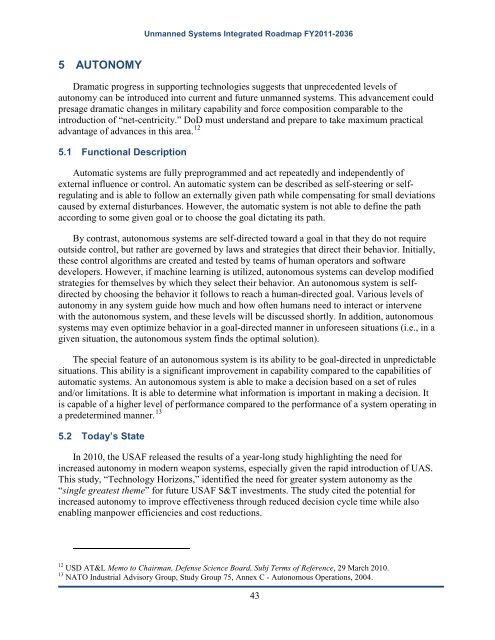Unmanned Systems Integrated Roadmap FY2011-2036 - Defense ...
Unmanned Systems Integrated Roadmap FY2011-2036 - Defense ...
Unmanned Systems Integrated Roadmap FY2011-2036 - Defense ...
Create successful ePaper yourself
Turn your PDF publications into a flip-book with our unique Google optimized e-Paper software.
5 AUTONOMY<br />
<strong>Unmanned</strong> <strong>Systems</strong> <strong>Integrated</strong> <strong>Roadmap</strong> <strong>FY2011</strong>-<strong>2036</strong><br />
Dramatic progress in supporting technologies suggests that unprecedented levels of<br />
autonomy can be introduced into current and future unmanned systems. This advancement could<br />
presage dramatic changes in military capability and force composition comparable to the<br />
introduction of “net-centricity.” DoD must understand and prepare to take maximum practical<br />
advantage of advances in this area. 12<br />
5.1 Functional Description<br />
Automatic systems are fully preprogrammed and act repeatedly and independently of<br />
external influence or control. An automatic system can be described as self-steering or selfregulating<br />
and is able to follow an externally given path while compensating for small deviations<br />
caused by external disturbances. However, the automatic system is not able to define the path<br />
according to some given goal or to choose the goal dictating its path.<br />
By contrast, autonomous systems are self-directed toward a goal in that they do not require<br />
outside control, but rather are governed by laws and strategies that direct their behavior. Initially,<br />
these control algorithms are created and tested by teams of human operators and software<br />
developers. However, if machine learning is utilized, autonomous systems can develop modified<br />
strategies for themselves by which they select their behavior. An autonomous system is selfdirected<br />
by choosing the behavior it follows to reach a human-directed goal. Various levels of<br />
autonomy in any system guide how much and how often humans need to interact or intervene<br />
with the autonomous system, and these levels will be discussed shortly. In addition, autonomous<br />
systems may even optimize behavior in a goal-directed manner in unforeseen situations (i.e., in a<br />
given situation, the autonomous system finds the optimal solution).<br />
The special feature of an autonomous system is its ability to be goal-directed in unpredictable<br />
situations. This ability is a significant improvement in capability compared to the capabilities of<br />
automatic systems. An autonomous system is able to make a decision based on a set of rules<br />
and/or limitations. It is able to determine what information is important in making a decision. It<br />
is capable of a higher level of performance compared to the performance of a system operating in<br />
a predetermined manner. 13<br />
5.2 Today’s State<br />
In 2010, the USAF released the results of a year-long study highlighting the need for<br />
increased autonomy in modern weapon systems, especially given the rapid introduction of UAS.<br />
This study, “Technology Horizons,” identified the need for greater system autonomy as the<br />
“single greatest theme” for future USAF S&T investments. The study cited the potential for<br />
increased autonomy to improve effectiveness through reduced decision cycle time while also<br />
enabling manpower efficiencies and cost reductions.<br />
12 USD AT&L Memo to Chairman, <strong>Defense</strong> Science Board, Subj Terms of Reference, 29 March 2010.<br />
13 NATO Industrial Advisory Group, Study Group 75, Annex C - Autonomous Operations, 2004.<br />
43

















